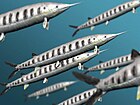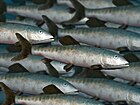Belonostomus
| Belonostomus Temporal range: Possible Paleocene record
| |
|---|---|

| |
| Belonostomus kochii | |
| Scientific classification | |
| Domain: | Eukaryota |
| Kingdom: | Animalia |
| Phylum: | Chordata |
| Class: | Actinopterygii |
| Order: | †Aspidorhynchiformes |
| Family: | †Aspidorhynchidae |
| Genus: | †Belonostomus Agassiz, 1834 |
| Type species | |
| †Aspidorhynchus tenuirostris Agassiz, 1833
| |
| Species | |
|
30+, see text | |
| Synonyms | |
|
Diphyodus | |
Belonostomus (from Greek: βέλος belos, 'dart' and Greek: στόμα stóma 'mouth')[1] is a genus of prehistoric ray-finned fish that was described by Louis Agassiz in 1844. It is a member of the order Aspidorhynchiformes, a group of fish known for their distinctive elongated rostrums.[2]
Fossils of Belonostomus have been found worldwide in marine deposits, although some species are known from freshwater habitats.[3] The oldest known species are from the Upper Jurassic of Germany and England, with the youngest known species from the late Maastrichtian. One specimen has been recovered from the late Paleocene of North Dakota, which would suggest that this genus was the only aspidorhynchean to survive into the Cenozoic, although it is possible this fossil may have been reworked from earlier formations.[3][4]
It likely consumed plankton or other small fish,[5] though one specimen from the Late Jurassic of Germany was found with the rhynchocephalian Homoeosaurus as stomach contents.[6]
Taxonomy[edit]
Known Belonostomus species are:[2][7][8]
- B. aciculiferus Nessov, 1985 - Turonian of Uzbekistan
- B. attentuatus Dixon, 1850 - Cenomanian of England[9] (nomen dubium)[8]
- B. cinctus Agassiz, 1837 - Cenomanian of England and Italy[3][10]
- B. comenianus (Kner, 1867) - Cretaceous of Slovenia (syn: Hemirhynchus comenianus Kner, 1867)
- B. crassirostris Costa, 1853 - Cenomanian of Morocco and Italy[11]
- B. dalmaticus Gorjanović-Kramberger, 1895 - Cenomanian of Croatia
- B. dorsetensis Woodward, 1895 - Kimmeridgian of England
- B. helgolandicus Taverne & Ross, 1973 - Aptian of Germany
- B. hooleyi Woodward, 1916 - Barremian of England
- B. genevensis (Pictet, 1858) - Early Cretaceous of Switzerland[7] (syn: Aspidorhynchus genevensis Pictet, 1858) (nomen dubium)[8]
- B. indicus Lydekker, 1890 - Maastrichtian of India[12] (nomen dubium)[8]
- B. kochii Agassiz, 1843 - Tithonian of Germany[13] (syn: B. kocki Agassiz, 1843)
- B. lamarquensis Bogan et al., 2011 - Campanian/Maastrichtian of Argentina[4]
- B. leptosteus Agassiz ex Egerton, 1836 - Bathonian of England (nomen dubium)[8]
- B. lesinaensis Bassani, 1882 - Cenomanian of Croatia and Slovenia (possibly synonymous with B. crassirostris)[10] (syn: Hemirhynchus heckelii Kner, 1867)[8]
- B. longirostris Lambe, 1902 - Santonian to late Maastrichtian of the Americas, including Canada (Alberta & Saskatchewan), the United States (Montana, North Dakota & Wyoming), Argentina, and Chile[14]
- B. marquesbritoi Taverne & Capasso, 2012 - Campanian/Maastrichtian of Italy
- B. matteuzi Gorjanović-Kramberger, 1895 - Cenomanian of Slovenia
- B. muensteri Agassiz, 1844 - Tithonian of Germany[13] (syn: B. speciosus Wagner, 1863)[8]
- B. novaki Gorjanović-Kramberger, 1895 - Cenomanian of Croatia
- B. ornatus Felix, 1891 - Berriasian of Mexico[15] (nomen dubium)[8]
- B. sphyraenoides Agassiz, 1844 - Tithonian of Germany (syn: B. brachysomus Agassiz, 1837, B. angustus zu Münster ex von Leonhard & Bronn, 1842)[8][13]
- B. tenuirostris (Agassiz, 1833) - Tithonian of Germany[13] and France (type species) (syn: Aspidorhynchus tenuirostris Agassiz, 1833, B. subulatus Agassiz, 1834, B. ventralis Agassiz, 1834)[8]
Indeterminate remains are known from worldwide, including the Gulf Coast of the United States (Alabama, Arkansas, and Texas),[15] Australia, Belgium, Lebanon, and Russia.[2]

The former species B. acutus Agassiz, 1844 (syn: B. tenellus Agassiz ex Egerton 1841) and B. anningiae Agassiz, 1843 from the early-mid Jurassic of England are now thought to be species of the unrelated saurichthyiform Saurorhynchus.[16] The former species B. carinatus Mawson and Woodward, 1907 from the Hauterivian of Brazil is now thought to be a stem-gar in the family Obaichthyidae.[17] The former species B. microcephalus Winkler, 1862 from the Tithonian of Germany is now thought to be a junior synonym of Aspidorhynchus acustirostris, while B. flexuosus Philips, 1871 is one of A. crassus.[18] The former species B. sweeti Etheridge & Woodward, 1892 is now placed in Richmondichthys. The former species B. pygmaeus Winkler, 1874 from the Tithonian of Germany is thought to be an immature specimen of one of the other Solnhofen Belonostomus species.[7]
References[edit]
- ^ Roberts, George (1839). An etymological and explanatory dictionary of the terms and language of geology. London: Longman, Orme, Brown, Green, & Longmans. p. 19. Retrieved 29 December 2021.
- ^ a b c "PBDB". paleobiodb.org. Retrieved 2024-03-07.
- ^ a b c Bryant, Laurie J. (1987). "Belonostomus (Teleostei: Aspidorhynchidae) from the Late Paleocene of North Dakota" (PDF). PaleoBios. 43. Museum of Paleontology, University of California Berkeley.
- ^ a b Agnolin, Federico. "Description of a new aspidorhynchid fish, Belonostomus lamarquensis sp. nov. (Halecostomi, Aspidorhynchiformes), from the continental Upper Cretaceous of Patagonia, Argentina". Bulletin de l'Institut Royal des Sciences Naturelles de Belqique, Sciences de la Terre.
- ^ Van Vranken, Nathan; Fielitz, Christopher; Ebersole, Jun (2019). "New occurrences of Belonostomus (Teleostomorpha: Aspidorhynchidae) from the Late Cretaceous of the North American Gulf Coastal Plain, USA". Palaeontologia Electronica. 22 (3): 1–11. doi:10.26879/983. ISSN 1935-3952. S2CID 204264731.
- ^ Frey, Eberhard; Tischlinger, Helmut (2012-03-07). Fenton, Brock (ed.). "The Late Jurassic Pterosaur Rhamphorhynchus, a Frequent Victim of the Ganoid Fish Aspidorhynchus?". PLOS ONE. 7 (3): e31945. Bibcode:2012PLoSO...731945F. doi:10.1371/journal.pone.0031945. ISSN 1932-6203. PMC 3296705. PMID 22412850.
- ^ a b c Brito, P. M. (1997). "Révision des Aspidorhynchidae (Pisces, Actinopterygii) du Mésozoïque : ostéologie, relations phylogénétiques, données environnementales et biogéographiques". Geodiversitas.
- ^ a b c d e f g h i j Woodward, Arthur Smith; Woodward, Arthur Smith; Woodward, Henry; History), British Museum (Natural (1895). Catalogue of the fossil fishes in the British Museum (Natural History), Cromwell Road, S.W. Vol. Pt.III. London: Printed by order of the Trustees.
- ^ "GB3D Type Fossils | High resolution photographs and digital models of British type fossils". www.3d-fossils.ac.uk. Retrieved 2024-03-07.
- ^ a b "The Cenomanian-Turonian ichthyofaunas from the Scaglia-type succession of northeastern Italy". www.research.unipd.it. Retrieved 2024-03-07.
- ^ Martill, David M.; Ibrahim, Nizar; Brito, Paulo M.; Baider, Lahssen; Zhouri, Samir; Loveridge, Robert; Naish, Darren; Hing, Richard (2011-08-01). "A new Plattenkalk Konservat Lagerstätte in the Upper Cretaceous of Gara Sbaa, south-eastern Morocco". Cretaceous Research. 32 (4): 433–446. doi:10.1016/j.cretres.2011.01.005. ISSN 0195-6671.
- ^ "Mineralienatlas - Fossilienatlas". www.mineralienatlas.de. Retrieved 2024-03-07.
- ^ a b c d Lane, Jennifer (2014-11-01). "The Species of the Genus Belonostomus (Neopterygii, Aspidorhynchiformes) in the Late Jurassic of the Solnhofen Archipelago" (PDF). Archaeopteryx. 32: 15–43.
- ^ Brito, Paulo M.; Suarez, Mario E. (2010-06-29). "Late Cretaceous Belonostomus (Pisces, Actinopterygii, Aspidorhynchidae) from Algarrobo, Chile, with comments on aspidorhynchid paleodistribution in South America". Andean Geology. 30 (1): 117–127. ISSN 0718-7106.
- ^ a b College~nvanvranken@sbcglobal.net, Nathan E. Van Vranken~Potomac State; College~cfielitz@ehc.edu, Christopher Fielitz~Emory & Henry; Center~Jebersole@mcwane.org, Jun A. Ebersole~McWane Science (2019-09-13). "New occurrences of Belonostomus (Teleostomorpha: Aspidorhynchidae) from the Late Cretaceous of the North American Gulf Coastal Plain, USA". Palaeontologia Electronica. Retrieved 2024-03-07.
- ^ Maxwell, Erin E.; Stumpf, Sebastian (2017-05-23). "Revision of Saurorhynchus (Actinopterygii: Saurichthyidae) from the Early Jurassic of England and Germany". European Journal of Taxonomy (321). doi:10.5852/ejt.2017.321. ISSN 2118-9773.
- ^ Brito, Paulo M.; Lindoso, Rafael M.; Carvalho, Ismar S.; de Paula Machado, Giselle (2016-04-01). "Discovery of †Obaichthyidae gars (Holostei, Ginglymodi, Lepisosteiformes) in the Aptian Codó Formation of the Parnaíba Basin: Remarks on paleobiogeographical and temporal range". Cretaceous Research. 59: 10–17. doi:10.1016/j.cretres.2015.10.017. ISSN 0195-6671.
- ^ López-Arbarello, Adriana; Schröder, Kerstin M. (2014-06-01). "The species of Aspidorhynchus Agassiz, 1833 (Neopterygii, Aspidorhynchiformes) from the Jurassic plattenkalks of Southern Germany". Paläontologische Zeitschrift. 88 (2): 167–185. doi:10.1007/s12542-013-0187-z. ISSN 1867-6812.
- Belonostomus, Paleobiology Database
- Prehistoric ray-finned fish genera
- Aspidorhynchiformes
- Late Jurassic bony fish
- Cretaceous bony fish
- Late Jurassic fish of Europe
- Late Cretaceous fish of Africa
- Late Cretaceous fish of Asia
- Cretaceous fish of Europe
- Cretaceous fish of North America
- Late Cretaceous fish of South America
- Mesozoic fish of Australia
- Fossils of the United States
- Fossils of Germany
- Fossils of England
- Fossils of India
- Fossils of Argentina
- Fossils of Canada
- Fossils of Chile
- Fossils of Croatia
- Fossils of Slovenia
- Fossils of Italy
- Fossils of Mexico
- Fossils of Morocco
- Fossils of Australia
- Fossils of Lebanon
- Fossils of Russia
- Fossils of Belgium
- Fossils of Switzerland
- Bissekty Formation
- Solnhofen fauna
- Bathonian genus first appearances
- Kimmeridgian genera
- Tithonian genera
- Berriasian genera
- Barremian genera
- Aptian genera
- Cenomanian genera
- Turonian genera
- Santonian genera
- Campanian genera
- Maastrichtian genus extinctions
- Fossil taxa described in 1834
- Taxa named by Louis Agassiz
- Prehistoric ray-finned fish stubs
- Cretaceous fish stubs







